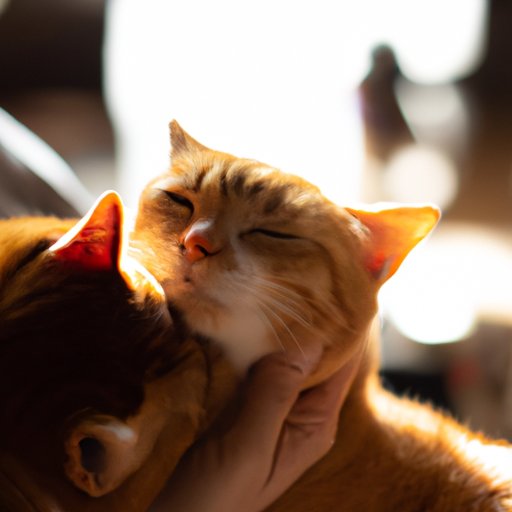I. Introduction
Most cat owners find their pet’s purring to be a calming and comforting sound, but have you ever wondered why cats purr? This article will explore the different reasons behind why cats purr and how it benefits both humans and felines alike.
Understanding the science and significance of a cat’s purr can improve the relationship between you and your furry friend, as well as help identify potential health concerns. Let’s get started.
II. The Science of Purring: Understanding the Feline Sound
Purring is a unique feline sound that occurs when the muscles in a cat’s larynx (voice box) vibrate. This occurs when the cat is inhaling and exhaling, which produces the familiar low rumbling sound.
While you might associate purring with contentment or happiness, cats can also purr when they are in pain or experiencing anxiety.
It’s also important to note that cats can make a variety of other sounds, including meows, hisses, growls, and chirps.
III. The Evolution of Cat Purring and Its Cultural Significance
Scientists believe that purring evolved as a way for cats to communicate with each other, particularly between a mother cat and her kittens. Through purring, the mother can stimulate her kittens to nurse and bond with them.
Purring has also played a significant role in different cultures throughout history. For example, ancient Egyptians believed that cats were sacred animals and worshipped as a deity. They believed that cats possessed healing powers and could ward off evil spirits with their purrs.
Interestingly, cats also tend to purr more when they are around humans, which may be a result of them trying to communicate and bond with us.
IV. 5 Surprising Facts About Why Cats Purr
1. Purring can be a form of communication.
Cats may use purring as a way to communicate their needs or wants to their owners. For example, if your cat is hungry, they may purr as a way to “ask” for food.
2. Purring can indicate pain or discomfort.
While purring is often associated with contentment, cats may also purr when they are in pain or seriously injured. If your cat is purring excessively or in a strange way, it’s important to take them to the vet to rule out any underlying health issues.
3. Purring can help cats heal faster.
Studies have shown that cats who purr may actually heal faster and recover more quickly from injuries. The vibrations produced by purring may help increase bone density and promote healing.
4. Purring can have a calming effect on humans.
Many people find that the sound of a cat purring is soothing and can even help reduce stress and anxiety. In fact, some therapists have even used purring as a form of therapy for their patients.
5. Purring can strengthen the bond between cat and owner.
When your cat purrs, it’s a sign that they trust and feel comfortable around you. Regularly petting and spending time with your cat can strengthen your bond and improve their overall wellbeing.
V. The Healing Power of a Cat’s Purr: How It Benefits Humans and Cats
The healing power of purring is not limited to cats alone. Studies have found that the sound of a cat purring can also benefit humans, particularly those suffering from high blood pressure, anxiety, and depression.
For cats, purring can help reduce stress and anxiety, as well as promote relaxation and pain relief. Some vets even recommend playing recorded purring sounds for cats who are undergoing surgery.
Case studies have also shown that cats who regularly purr have a lower risk of developing health problems, including heart disease and respiratory issues.
VI. The Connection Between a Cat’s Purr and Their Mood
A cat’s mood can have a significant impact on their purring habits. Happy and content cats will often purr softly and steadily, while anxious or stressed cats may purr in short bursts or stop purring altogether.
It’s also important to pay attention to the pitch and tone of your cat’s purring, as this can be an indication of their mood. High-pitched purring may indicate excitement or discomfort, while low-pitched purring may signal relaxation and contentment.
If your cat stops purring altogether, this may also be a sign that they are experiencing some sort of emotional or physical stress.
VII. The Different Types of Purring and What They Mean for Your Cat’s Health
There are different types of purring sounds that cats can make, and understanding them can be helpful in identifying potential health concerns.
For example, a cat purring while kneading their paws may indicate that they are feeling happy and content. However, a cat who is purring loudly and abruptly may be experiencing pain or discomfort.
If you notice any changes in your cat’s purring habits, such as frequent or prolonged purring, it’s important to take them to the vet for a check-up. Changes in purring can be an indication of underlying health problems, including respiratory issues, cancer, or neurological disorders.
VIII. Conclusion
Purring is a unique and fascinating sound that cats make for a variety of reasons. Understanding the science and significance behind purring can improve your relationship with your kitty and help identify potential health concerns.
The healing power of a cat’s purr is also something to appreciate and cherish, as it can benefit both cats and humans alike. So next time your feline friend starts to purr, take a moment to appreciate the unique bond that you share.
